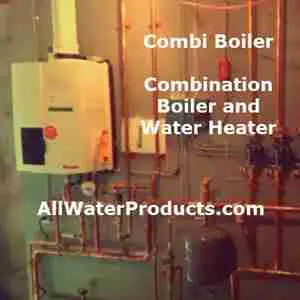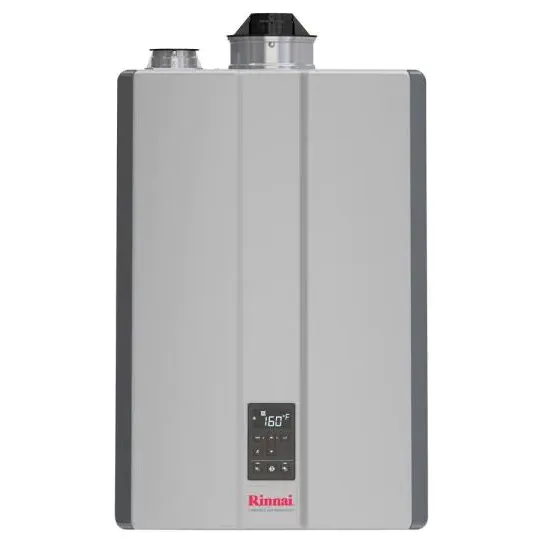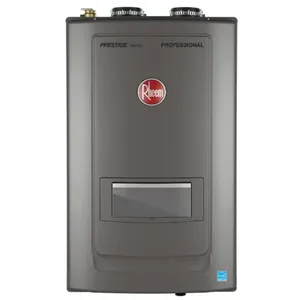Replacing a boiler or furnace and a hot water heater as separate units is not always the best idea. Buying a combi boiler that replaces both of them with just one device could save you money. Also, it will fit in a much small space.
There’s nothing scary about a combination boiler and hot water heater, and I will explain everything you need to know.
No products found.
Table of Contents
High Efficiency Combination Boiler and Hot Water Heater
A high efficiency combination boiler, also known as combi boilers, not only heat water for domestic use, but also provide space heating in a single unit.
Whether you need a hot relaxing bath, or want to make sure your bedroom (or any other room) is nice and toasty, a combi boiler will provide you with both.
What Is A Combi Boiler and How Does It Heat The House and The Water?
A Combi, or combination boiler, provides high efficiency domestic hot water and space heating in one condensed footprint. These units are very easy to install and to maintain.
When opening a hot water tap (faucet), cold water flows into the heat exchanger. The fire tube heat exchanger then supplies boiler water that has been heated to the desired temperature to the tap (faucet).

However, if space heating is required, then the heated boiler water is directed to the external space heating loop via a diverter valve.
What Is The Difference Between A Traditional Boiler And A Combi Boiler?
Although both types of boilers can be used to provide hot water and heat your home, there are some key differences.
A traditional boiler has been primarily designed for space heating. The boiler supplies hot water that is then circulated through a hydronic heating system or radiators to heat the ambient air.
Water from a traditional boiler may also be used to heat domestic water by routing the water through an integrated, separate water heating unit before directing it to a shower or a faucet.
Although many traditional boilers require additional water treatment, some models are compatible with potable water.
A combi boiler has been designed for both water heating and space heating with a single unit. Combi boilers produce hot water on demand, similarly to tankless water heaters. They also switch between space heating and water heating seamlessly, thus providing the best possible solution.
Do Combi Boilers Save Money?
A Combi boiler is highly efficient for both water and space heating, and using these units will result in lower energy costs in a home. Also, since a combi boiler doesn’t have a water tank, that adds to the overall efficiency. So, yes, a combi can save you money with lower operational expenses.
Is A Combi Boiler Energy Efficient?
Well, I just said they were didn’t I? But don’t take my word for it. Combi boilers are ENERGY STAR rated and have an Annual Fuel Utilization Efficiency (AFUE) rating of 95% or better.
As combi boilers heat both water and spaces, it’s like having two high efficiency appliances in one.
Combi boilers also use modulating combustion systems with turndown ratios of typically around 5:1.
This ensures high efficiency operations, even during reduced heating demands. Say what? Let me explain.
Good Value – Energy saving natural gas condensing boiler – No products found.
What’s This Turndown Ratio for Gas Heaters Really Mean?
The turndown ratio of a heater compares the maximum and minimum heat output of the unit.
The turndown ratio for a direct gas fired burner, where air is forced through the flame, is typically 25:1. This means that the burner is able to modulate the heat output from just 4% of full heat volume, all the way up to 100% of full fire.
The turndown ratio for an indirect gas heater is just 2:1, which means the heat output is modulated from 50% of full fire and up to 100% of full fire.
In other words, the typical indirect gas heater does a poor job of producing lower amounts of heat. Which means it can waste gas by burning more gas than is actually needed.
Electronic Modulation To The Rescue
So, how does a combination (combi) boiler actually work?
An indirect fired make-up air (MUA) heating unit separates the heated air that is sent to the house heat register, from the gases in the combustion chamber where the heat is actually produced.
So, the main air fan sends the heated air to the heat registers to warm the house. Meanwhile, a different blower circulates the air-fuel mixture through the heat exchanger.
That way, the noxious fumes from the burning gas is kept separate from the air that is delivered into the house.
Electronic modulation allows for exact control of the amount of heat produced by the heater. In a furnace this is known as the Leaving Air Temperature (LAT). Think of it as the temperature of the heat coming out of the heat register in the house.
If the heat coming from the heat register or radiator is high, then you will have wide temperature swings within the house. Also, that means the heater is running for shorter periods of time, which is less energy efficient, and costs you money.
However, electronic modulation of the flame can improve the turn down ratio which provides better comfort in the home, and is more energy efficient. In other words, it does a better job of controlling the Leaving Air Temperature (LAT).
So, as the outdoor air temperatures changes, the furnace modulates the gas flow to deliver a constant LAT. This keeps the house comfortable, while not wasting gas by overheating the house.
However, many indirect gas-fired make-up air (MUA) manufacturers only sell electronic modulation heaters with a 2:1 turndown. This limited turndown modulation range, as have already mentioned, will cost you money, and the house will be less comfortable.
The crucial point is that a make-up air heater that is using electronic modulation, only provides exact temperature control while the furnace is operating within the modulation range.
The boiler/furnace will operate like a single-stage heating unit (full off or full on), while it is operating outside the modulation range. Which will result in temperature swings in the air coming out of the heat registers.
The turndown ratio will determine how often the heater will run within its modulation range. Reasonable estimates are provided in the table below:
| Turndown Ratio | Amount Of Time Heater Operates Within Its Modulation Range | Amount Of Time Heater Operates As A Single Stage heater (Full On or Full Off) | |
| 2:1 | 40% (Poor) | 60% (Poor) | |
| 4:1 | 80% (Good) | 20% (Good) | |
| 8:1 | 95% (Excellent) | 5% (Excellent) | |
So, you want to buy a boiler system that has the highest turndown ratio you can afford. That way the operation of the boiler in the modulation range is maximized. Which provides more consistent heating temperatures and therefore smaller temperature swings within the household.
High Efficiency Combi Boiler Overview
Two In One “Combi” – One long lasting heating unit provides both domestic hot water and space heating.
High Efficiency – An Annual Fuel Utilization Efficiency (AFUE) rating of 95% translates to energy savings and potential rebates.
A combi heater with an AFUE rating of 95% can deliver 95 BTUs of heat for every 100 BTUs of gas input. This means some customers may qualify for local and/or utility rebates.
Separate Heating Loops – Water for domestic hot water and space heating is kept in two separate loops.
Incredible – No products found.
Reduced Greenhouse Gas Emissions – The burner used reduces carbon monoxide and nitrogen oxide emission and meets all Ultra Low NOx emission standards recognized nationally.
Saves Energy – The combi boiler only produces domestic hot water when required, thus saving money and energy.
Decreased Installation Costs – Combi boilers are installed with 2″ and 3″ Schedule 40 PVC venting. As this costs less and is easier to work with than stainless steel, you save installation time and money.
Space Saving – As a single combi boiler replaces both your storage tank water heater and boiler, it frees up valuable space.
Turndown ratios as high as 11:1 – High tech gas flow control systems provide a high turndown ratio. Thereby reducing excessive combi-boiler cycling and energy waste, while enhancing temperature control for domestic hot water.
Maximum equivalent venting lengths – Venting lengths of 50′ for 2″ and 100′ for 3″ means it’s easier to install in tight spaces, and at lower cost.
Do I Really Need A Combi Boiler Water Heater?
Honestly, that depends on what your personal situation is, and whether a combi boiler will save you money during the time you are going to live in the house.
If you have just replaced either the boiler/furnace or water heater, then buying a combi boiler is probably going to cost more than just replacing the other device.
An exception to this, is if you are remodeling a large portion of the house. In that case you might need to free up some space.
Noritz NRCB180DV-NG natural gas Indoor Direct Combination Boiler (Standard Vent Convertible) with Built-in Pump, max 180,000 DHW, 9.8 Gpm, 100,000 Btuh Space Heating- No products found.
Or if you increased the insulation in the house, and the heater you currently have is now too powerful (over sized) for what you need.
When a boiler or water heater is over sized, they turn on and off frequently which wastes energy, costs you money, and will prematurely wear out the equipment.
The time to save a bunch of money is when you need to replace both the boiler/furnace and the hot water heater.
Want help repairing or installing a combi boiler? Click Here
Gas Boilers vs. Forced Air Furnaces – What’s The Difference?
The majority of homes in the U.S. are still heated with either gas boilers or gas (forced air) furnaces.
Furnaces heat air, and the heated air is distributed through the house via ducts until it exits through a heat register.
Boilers are used to heat water, providing either steam or hot water for heating.
The hot water is sent through metal pipe or PEX tubing, either to radiant floor systems or baseboard radiators. Or it can be used to heat air via a coil. Whereas, steam is sent through metal pipe to radiators.
Normally, steam boilers are inherently less efficient vs. hot water boilers. However, you can get a high-efficiency boiler that will rival the efficiency of hot water boilers. However, steam boilers can be a good choice for larger buildings.
Understanding Efficiency Ratings of Boilers and Furnaces
The efficiency of central furnaces and boilers is measured with their annual fuel utilization efficiency (AFUE).
It is a Federal Trade Commission requirement that new boilers and furnaces display their AFUE rating. This is to allow consumers to comparison shop the heating efficiencies of different brands and product models.
The AFUE measures how efficiently the appliance converts its fuel energy into heat over a period of a year.
The AFUE is the ratio of a boiler or furnace’s annual heat output compared to the boiler or furnace’s total annual fossil fuel energy consumption.
An AFUE of 90% translates to 90% of the fuel’s energy being turned into heat for the home, while the remaining 10% is wasted as it goes up the chimney or elsewhere.
It should be noted that the AFUE does not include heat lost through the pipes or ductwork system. That can be as much as 35% of the furnace’s output energy when ducts are located in attics, garages, or other unconditioned or partially conditioned spaces.
All-electric boilers and furnaces do not have any wasted energy going out through a chimney. So, their AFUE ratings are in the range of 95% to 100%. That 95% rating is typical for heaters that are installed outdoors. That’s because the heater is exposed to colder temperatures.
Despite all-electric boilers and furnaces being highly efficient, they are usually too expensive to operate. That’s due to the high cost of electricity in many parts of the country.
A system’s efficiency can be identified and compared not only by using its AFUE, but also by the equipment’s features.
Really old heating systems that have very low efficiency, have these features:
- Heavy metal heat exchangers.
- Continuously burning pilot lights.
- AFUE ratings of between 56% and 70%.
Moderately efficient heaters:
- Electronic ignition (no pilot light).
- The flow of combustion gases and combustion air is accurately controlled by the exhaust fans.
- The exhaust (flue) pipes are smaller in diameter.
- Cycling losses reduced by lighter weight and compact size.
- AFUE rating of between 80% and 83%.
Highly efficient heaters:
- Uses air from outside of the house for combustion (Sealed combustion).
- Extra efficiency obtained by condensing exhaust (flue) gases in a second heat exchanger.
- AFUE rating of between 90% and 98.5%.
Non-Sealed vs. Sealed Combustion Boiler
Select a sealed combustion boiler or furnace, as these exhaust flue gases directly to the outside. Since they bring outside air directly into the burner, there is no need for a damper or draft hood.
Whereas, non-sealed combustion boilers and furnaces take heated air out of the house for combustion and then throw that air outside. This wastes the energy that was used to heat the air.
A sealed-combustion unit prevents this problem, while at the same time preventing the risk of dangerous combustion gases being introduced into your home. In a non-sealed-combustion furnace, back-drafting of combustion gases can cause big problems.
In general, a high-efficiency sealed-combustion unit produces acidic exhaust gas that isn’t suitable for older, unlined chimneys. Fortunately, new heaters can be vented through metal or even “heat rated” plastic pipe.
That means you can get rid of a heat stealing chimney, save money, and have more usable space in the house.
Replacing a Boiler or Furnace. Should You?
Older furnaces and boilers are costing you money, because they are only between 56% and 70% efficient. Whereas, a new heating system can be as high as 98.5% efficient .
That means you can drastically slash your heating bill. Also, you will cut the amount of pollution output by the furnace or boiler by upgrading your heating system.
However, you can save even more money by first making energy efficiency upgrades that reduces the size of your new heater.
So, first, you want to reduce the amount of air loss, and heat loss by caulking and insulating.

90,000 BTU Output Condensing Boiler – Water Heater. AFUE 95%. Con be converted to propane. Click Here
In colder climates, replacing an old oil fuel boiler or furnace with one that is 90% efficient will save 2.5 tons of carbon dioxide air pollution each year. If you heat with gas, you will reduce air pollution by 1.5 tons a year.
So, if the boiler or furnace is more than 8 years old, you should probably replace it. Especially if you just remodeled the house and added insulation, or caulked up all the cracks around windows and doors.
Also, if your gas furnace has a pilot light rather than an electronic ignition, then do yourself a favor and buy a new heater.
A boiler or furnace that is sized properly will operate most efficiently, and you’ll want to select a dependable unit and compare the warranties of the furnaces or boilers you’re considering.
When deciding on a high-efficiency furnace or boiler, look for the ENERGY STAR label.
In cold climates, it makes sense to purchase the highest-efficiency combi boiler system.
For milder climates with lower annual heating costs, the extra investment needed to buy 95% efficiency rather than, for example 80%, may be difficult to justify.
It depends upon the cost of fuel where you live, and whether you expect fuel prices to increase.

Heat hot water and the house, and save money – Click Here
AllWaterProducts.com Home Page
Last update on 2025-11-29 / Affiliate links / Images from Amazon Product Advertising API